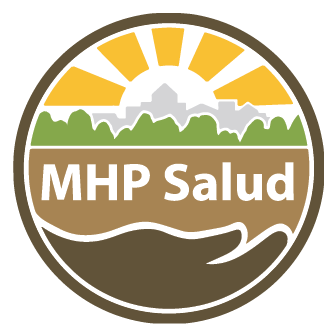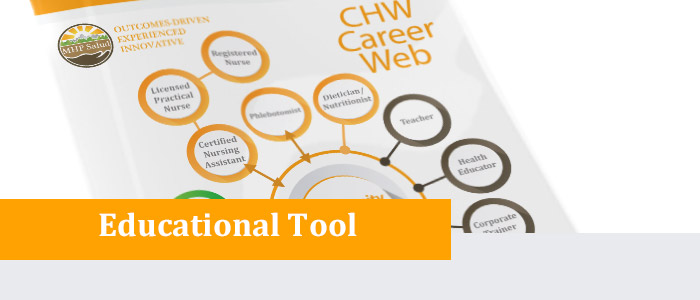Careers in Health, Education, and Social Work Spotlight
Published September 2020 | Back to all news and updates
Community Health Workers Have Many Career Paths
The unique nature of work performed by Community Health Workers (CHWs) allows them to cross over into many different career paths. Typically, the progression from one career to the next is visualized as a “career ladder” which describes climbing upwards towards a better or higher-paying position. However, because the skillset required of a CHW overlaps with skillsets required from many other professions, a CHW’s career movement cannot solely be described as going “up” and “down” or being better or worse.
Rather, a “career web”, which allows for movement in many directions, better depicts the idea that there are a variety of different paths that can lead an individual into and out of the CHW profession.
Although there are different career paths for a CHW, many people have vibrant and successful careers as lifelong CHWs. As with all things in the workforce, longer experience in a role often increases how effective an individual is in that role.
Each month, we will highlight the journey of individuals’ professional development into roles within and outside of the CHW profession. The first story is about Diana’s journey from CHW to Phlebotomist. The second features Nina, who also became a Phlebotomist, but unlike Diana, she did not start out as a CHW. This story is included to illustrate how the CHW profession builds skillsets that are desirable across industries. It is also included to illustrate the key differences between the CHW profession and other careers in related fields.
Diana’s Story: From Community Health Worker to Phlebotomist

Diana was employed as a CHW at a community health center (CHC) for about six years. Her responsibilities included performing outreach, screening for social determinants of health needs, and providing referrals. During her time as a CHW, she enjoyed watching her colleagues perform their clinical duties, particularly the laboratory staff. She decided that she would be interested in finding a position more clinically driven and task-focused. In fact, she was beginning to feel burnt out in her role as CHW and felt like she could never do enough to help patients and their families. She began talking to individuals in the care team to get a sense of where she should go. She made a point to mention that she did not want to go into an extensive education program. Based on her preferences, many of her colleagues recommended that she become a phlebotomist. They explained that it would require a short educational course as well as certification, and with her experience, the process would be quick. Per their recommendation, she decided to venture into becoming a phlebotomist.
Diana began the journey to becoming a phlebotomist by enrolling in a program at a vocational tech school. Her prior experience helped her breeze through the program in about nine weeks. Following the completion of the education program, she started looking into becoming certified. It was not required in the state, but employers commonly required it. She decided to take the exam as it would expand her options for finding employment. She took the exam and after one attempt earned her certification. Once she became certified, she started to search for jobs. The CHC she worked at was not hiring, but her colleagues did send recommendations to organizations that were hiring. She very swiftly found a position and began her career as a phlebotomist at a diagnostics center.
Nina’s Story: From Medical Recpetionist to Phlebotomist

Nina worked as a receptionist at an urgent care clinic for quite some time. She had always admired the medical staff and wanted to work alongside them. Once she started feeling comfortable in her role, she determined it was time to venture into clinical work. She began talking with people around the office to get a sense of what kind of position would be best for her. Her first conversation was with a CHW at the clinic. The CHW explained the role would entail outreach, health education, and eligibility assistance. Nina considered the position but decided it did not have the level of clinical work she was looking for. Eventually, a conversation with the clinic’s phlebotomists had piqued her interest and seemed like a viable option. Her coworkers explained that the position required the completion of an education program, and possibly certification. Additionally, the role would be a significant step for future clinical work. Ultimately, she decided to begin the process of becoming a phlebotomist.
Nina enrolled in a phlebotomist education program at a community college. During her time in school, she was able to keep her job because the clinic she worked at was open outside of her program’s hours. The program took her about a year to complete. Following
graduation, she started to look into certification. She decided to become certified as it would provide more employment opportunities. She signed up for the certification exam with an exam provider recognized by the state health department. After two attempts, she
passed the exam and began searching for a position. She eventually got a job as a phlebotomist at a local hospital.
Note these stories are based on real-life scenarios but contain fictional characters.
Our CHW Career Web Model resources demonstrate the numerous ways that an individual can find themselves becoming a CHW or how they may progress their career under various ‘career clusters’ like social work, clinical, or advocacy after being a CHW. These resources can be used as tools by organizations that work with CHWs such as community-based organizations, CHW Associations, Federally Qualified Health Centers (FQHCs), Primary Care Associations (PCAs), and Area Health Educations Centers (AHECs) to help explain the different career trajectories those in the CHW workforce have.
Blog Topics
About MHP Salud

MHP Salud has over 35 years of experience implementing CHW programs and training organizations looking to start and/or strengthen their own CHW programs. Visit our CHW Training & Consulting Services page to learn more about how we can help.







